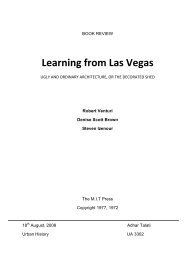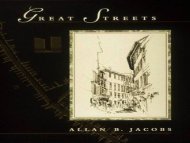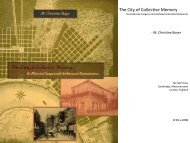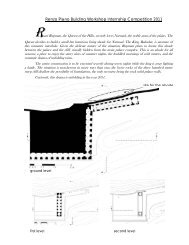Influence of millowners on Ahmedabads planning
Influence of millowners on Ahmedabads planning
Influence of millowners on Ahmedabads planning
You also want an ePaper? Increase the reach of your titles
YUMPU automatically turns print PDFs into web optimized ePapers that Google loves.
RISE AND INFLUENCE OF MILL-OWNERS ON<br />
THE PLANNING OF AHMEDABAD<br />
The Rise <str<strong>on</strong>g>of</str<strong>on</strong>g> Mill-owners<br />
The nineteenth century brought about important changes in the ec<strong>on</strong>omy and society <str<strong>on</strong>g>of</str<strong>on</strong>g><br />
Ahmedabad. First there was a substantial expansi<strong>on</strong> in the volume <str<strong>on</strong>g>of</str<strong>on</strong>g> trade both to and from the<br />
city. Sec<strong>on</strong>d the city's positi<strong>on</strong> relative to other commercial centers changed significantly<br />
because <str<strong>on</strong>g>of</str<strong>on</strong>g> the expansi<strong>on</strong> <str<strong>on</strong>g>of</str<strong>on</strong>g> the railway. But the most significant change in Ahmedabad during<br />
the nineteenth century was, however, the growth <str<strong>on</strong>g>of</str<strong>on</strong>g> the mill industry. The first mill came up in<br />
1858 mainly due to the efforts <str<strong>on</strong>g>of</str<strong>on</strong>g> a Nagar Brahmin, Ranchhodlal Chhotalal.<br />
The growth <str<strong>on</strong>g>of</str<strong>on</strong>g> the mill industry had a c<strong>on</strong>siderable impact <strong>on</strong> the city's life. It led to the<br />
emergence <str<strong>on</strong>g>of</str<strong>on</strong>g> certain new social identities. The <str<strong>on</strong>g>millowners</str<strong>on</strong>g> and the working class were the social<br />
identities that started to emerge in Ahmedabad city in the wake <str<strong>on</strong>g>of</str<strong>on</strong>g> the growth <str<strong>on</strong>g>of</str<strong>on</strong>g> the mill<br />
industry. The growth <str<strong>on</strong>g>of</str<strong>on</strong>g> the mill industry also caused c<strong>on</strong>siderable problems <str<strong>on</strong>g>of</str<strong>on</strong>g> polluti<strong>on</strong>,<br />
c<strong>on</strong>gesti<strong>on</strong> and insanitary c<strong>on</strong>diti<strong>on</strong>s in the city.<br />
The extreme c<strong>on</strong>gesti<strong>on</strong>, diseases and death rate not <strong>on</strong>ly threatened the further growth <str<strong>on</strong>g>of</str<strong>on</strong>g> the<br />
mill industry but also the very survival <str<strong>on</strong>g>of</str<strong>on</strong>g> Ahmedabad as a social and ec<strong>on</strong>omic entity. The two<br />
groups which were the most c<strong>on</strong>cerned were<br />
1. The col<strong>on</strong>ial policy makers who saw potential in Ahmedabad as a major textile center<br />
2. The mill owners who had invested in the land bey<strong>on</strong>d the walls foreseeing Ahmadabad’s<br />
future growth.<br />
What followed thereafter was a struggle between these two groups to take c<strong>on</strong>trol over the<br />
Municipality. Government tried to c<strong>on</strong>trol the <strong>planning</strong> by appointed the Committee <str<strong>on</strong>g>of</str<strong>on</strong>g><br />
Management to supersede the Municipal Board but owing to the mass public outrage and<br />
dem<strong>on</strong>strati<strong>on</strong> could not fulfill its objectives.<br />
The <str<strong>on</strong>g>Influence</str<strong>on</strong>g> <str<strong>on</strong>g>of</str<strong>on</strong>g> the New Indian Elite Group<br />
The new Indian elites did not c<strong>on</strong>stitute a well-defined political party or group in the initial<br />
period. Individuals who functi<strong>on</strong>ed as the key members <str<strong>on</strong>g>of</str<strong>on</strong>g> this group included industrialists like<br />
Kasturbhai Lalbhai and Ambalal Sarabhai, Vallabhbhai Patel, a trade uni<strong>on</strong>ist and, Shankarlal<br />
Banker. N<strong>on</strong>e <str<strong>on</strong>g>of</str<strong>on</strong>g> these new men came from existing prominent families in the city.<br />
In 1915 Municipal Board was reinstated .The elite leaders took advantage <str<strong>on</strong>g>of</str<strong>on</strong>g> this situati<strong>on</strong> to<br />
acquire a certain degree <str<strong>on</strong>g>of</str<strong>on</strong>g> c<strong>on</strong>trol over the Municipality. Here they were helped by the fact that<br />
these new leaders had already gained substantial c<strong>on</strong>fidence am<strong>on</strong>g the people by organizing
City Reader : Rise and <str<strong>on</strong>g>Influence</str<strong>on</strong>g> <str<strong>on</strong>g>of</str<strong>on</strong>g> Millowners <strong>on</strong> the Planning <str<strong>on</strong>g>of</str<strong>on</strong>g> Ahmedabad 2<br />
protests against the government's various interventi<strong>on</strong>ist measures. In 1917, Vallabhbhai Patel,<br />
the foremost leader <str<strong>on</strong>g>of</str<strong>on</strong>g> this group was elected to the Municipal Board. Vallabhbhai's group tried<br />
to c<strong>on</strong>solidate their positi<strong>on</strong> in the Municipality and in the city in a variety <str<strong>on</strong>g>of</str<strong>on</strong>g> ways. Firstly, they<br />
tried to achieve this by removing from <str<strong>on</strong>g>of</str<strong>on</strong>g>fice certain abrasive and arrogant government <str<strong>on</strong>g>of</str<strong>on</strong>g>ficials<br />
who then still dominated the municipal administrati<strong>on</strong>. At the same time the new elite leaders<br />
tried to broaden their political base through the extensi<strong>on</strong> <str<strong>on</strong>g>of</str<strong>on</strong>g> municipal franchise in the city.<br />
Vallabhbhai's group tried to ensure that the social groups which would tend to support their<br />
efforts in the Municipality and to whose ranks most <str<strong>on</strong>g>of</str<strong>on</strong>g> their members bel<strong>on</strong>ged secured more<br />
representati<strong>on</strong> <strong>on</strong> the Municipal Board. However, in extending the franchise the new political<br />
elites were careful to keep the expanded franchise restricted to the property-holding, tax and<br />
rent-paying secti<strong>on</strong>s and the salaried middle classes in the urban society.<br />
The sec<strong>on</strong>d way in which Vallabhbhai's group tried to strengthen their positi<strong>on</strong> was by forging<br />
alliances with the leaders <str<strong>on</strong>g>of</str<strong>on</strong>g> the different ec<strong>on</strong>omic interests in Ahmedabad. Vallabhbhai's group<br />
also looked for allies in the local communities <str<strong>on</strong>g>of</str<strong>on</strong>g> the pols. By 1918, a large number <str<strong>on</strong>g>of</str<strong>on</strong>g> members<br />
and supporters <str<strong>on</strong>g>of</str<strong>on</strong>g> Vallabhbhai's group had been elected to the different municipal Committees. 3<br />
Significantly, most <str<strong>on</strong>g>of</str<strong>on</strong>g> these men were either members <str<strong>on</strong>g>of</str<strong>on</strong>g> the emerging industrial bourgeoisie or<br />
were prominent lawyers, doctors, school teachers and other pr<str<strong>on</strong>g>of</str<strong>on</strong>g>essi<strong>on</strong>als <str<strong>on</strong>g>of</str<strong>on</strong>g> the city. 3 C<strong>on</strong>trol<br />
over these various municipal committees helped Vallabhbhai's group to intervene in different<br />
spheres <str<strong>on</strong>g>of</str<strong>on</strong>g> the city's life very effectively at a later stage.<br />
The Reorganizati<strong>on</strong> <str<strong>on</strong>g>of</str<strong>on</strong>g> Ahmedabad City by the Indian Elite Leaders<br />
Once the city leaders assumed c<strong>on</strong>trol <str<strong>on</strong>g>of</str<strong>on</strong>g> the Municipality, they started to use the infrastructural<br />
facilities provided by that instituti<strong>on</strong> to bring about a transformati<strong>on</strong> <str<strong>on</strong>g>of</str<strong>on</strong>g> Ahmedabad city. They<br />
were attempting to establish a new political, social and cultural order in Ahmedabad.<br />
1920s<br />
One <str<strong>on</strong>g>of</str<strong>on</strong>g> the first steps the elite leaders took was the restructuring and opening up <str<strong>on</strong>g>of</str<strong>on</strong>g> Pols in order<br />
to 'relieve' the c<strong>on</strong>gesti<strong>on</strong> in the urban centre. Plans were formulated for the acquiring houses,<br />
kotdas, walls and medas in the various streets and pols inside the city, so that two or more streets<br />
could be c<strong>on</strong>nected and plots opened up as air spaces to provide light and ventilati<strong>on</strong>. 3<br />
Then they turned their attenti<strong>on</strong> towards the lands outside the city walls.<br />
Jamalpur Scheme<br />
In 1918, a scheme was proposed to reorganize according to the new spatial order a piece <str<strong>on</strong>g>of</str<strong>on</strong>g> land,<br />
to the south <str<strong>on</strong>g>of</str<strong>on</strong>g> the city wall between the Jamalpur and Astodia Gates. In April 1920, the<br />
Municipal Board decided to impose a land tax <str<strong>on</strong>g>of</str<strong>on</strong>g> two per cent <strong>on</strong> the situati<strong>on</strong> value <strong>on</strong> 'open'<br />
lands, situated <strong>on</strong> the outskirts <str<strong>on</strong>g>of</str<strong>on</strong>g> the city, so as to bring those lands to n<strong>on</strong>-agricultural use by<br />
the people from the city.<br />
Urban History VI Rahul Raina 2404
City Reader : Rise and <str<strong>on</strong>g>Influence</str<strong>on</strong>g> <str<strong>on</strong>g>of</str<strong>on</strong>g> Millowners <strong>on</strong> the Planning <str<strong>on</strong>g>of</str<strong>on</strong>g> Ahmedabad 3<br />
Ellis Bridge Town Planning Scheme<br />
In April 1921, the Municipality proposed a scheme to cover an area <str<strong>on</strong>g>of</str<strong>on</strong>g> about 700 acres. The<br />
project included land outside the municipal limits in Shekhpur Khanpur, Changispur,<br />
Chhadawad, Usmanpur, Kocharab and Paldi were also included in the scheme.<br />
City Wall scheme<br />
In November 1924 the Town Planning Committee <str<strong>on</strong>g>of</str<strong>on</strong>g> the new Municipal Board c<strong>on</strong>trolled by<br />
Vallabhbhai Patel's group asked Mirams, the C<strong>on</strong>sulting Surveyor to Government, to prepare<br />
scheme for c<strong>on</strong>structing a circular road round the city either by demolishing the city wall or in<br />
some other way. Mirams was specially asked to suggest the acquisiti<strong>on</strong> <str<strong>on</strong>g>of</str<strong>on</strong>g> as few private<br />
properties as possible.<br />
Through these schemes the mill owners laid platform for the next stage <str<strong>on</strong>g>of</str<strong>on</strong>g> social restructuring<br />
which was to come ahead. The planned z<strong>on</strong>es were to have 'fixed' z<strong>on</strong>es <str<strong>on</strong>g>of</str<strong>on</strong>g> commerce and<br />
residence, c<strong>on</strong>trary to what had existed before. The process <str<strong>on</strong>g>of</str<strong>on</strong>g> town <strong>planning</strong> also allowed them<br />
to tweak the system <str<strong>on</strong>g>of</str<strong>on</strong>g> land valuati<strong>on</strong> for a scenario which would benefit their plans. So<br />
accordingly Area to the west <str<strong>on</strong>g>of</str<strong>on</strong>g> Sabarmati and in the center <str<strong>on</strong>g>of</str<strong>on</strong>g> the city was price valued high<br />
while the area which was to demarcated later as an “industrial z<strong>on</strong>e” was valued low.<br />
1940s / Post independence<br />
In the reorganized city the thrust was to develop the area around the Gujarat Vidyapeeth and the<br />
Gujarat College, <strong>on</strong> the western side <str<strong>on</strong>g>of</str<strong>on</strong>g> the river, as the new area <str<strong>on</strong>g>of</str<strong>on</strong>g> high status or importance.<br />
Gujarat Vidyapeeth occupied a central role in the n<strong>on</strong>-co-operati<strong>on</strong> movement that the new urban<br />
leaders launched in Ahmedabad in 1920. During the period from the 1930s through to the 1960s,<br />
the area around the Gujarat Vidyapeeth developed as the new 'cerem<strong>on</strong>ial centre' <str<strong>on</strong>g>of</str<strong>on</strong>g> the city,<br />
replacing the old <strong>on</strong>e <str<strong>on</strong>g>of</str<strong>on</strong>g> the Bhadra fort.<br />
The first textile mills in the city had sprung up <strong>on</strong> the periphery <str<strong>on</strong>g>of</str<strong>on</strong>g> city wall, to the left <str<strong>on</strong>g>of</str<strong>on</strong>g> the<br />
railway line. But later, the textile mills came up to the right <str<strong>on</strong>g>of</str<strong>on</strong>g> the railway line. This area, lying<br />
between the Asarwa and Maninagar railway stati<strong>on</strong>, later <strong>on</strong> developed as an industrial belt. In<br />
additi<strong>on</strong> to textile mills, a number <str<strong>on</strong>g>of</str<strong>on</strong>g> heavy engineering works were established in this regi<strong>on</strong>.<br />
Close to this industrial z<strong>on</strong>e, to the east <str<strong>on</strong>g>of</str<strong>on</strong>g> the city, extending into Asarwa, Saraspur and<br />
Gomtipur, grew up the working class area. Neighbourhood associati<strong>on</strong>s formed <strong>on</strong>e <str<strong>on</strong>g>of</str<strong>on</strong>g> the most<br />
prominent ways in which the workers organized themselves. Mill owners began to create new<br />
neighbourhoods for the workers and tried to ensure that these were not organized <strong>on</strong> the basis <str<strong>on</strong>g>of</str<strong>on</strong>g><br />
caste, religi<strong>on</strong> or the regi<strong>on</strong>al identity <str<strong>on</strong>g>of</str<strong>on</strong>g> the workers as previous living areas had been. Rather,<br />
workers from different caste, religious and regi<strong>on</strong>al backgrounds were forced to live together in<br />
these new neighbourhoods. The strategy was that this would not <strong>on</strong>ly destroy all the previous<br />
neighbourhood and patr<strong>on</strong>age networks am<strong>on</strong>g the workers but would also 'homogenize' them<br />
and bestow <strong>on</strong> them a new identity.<br />
Urban History VI Rahul Raina 2404
City Reader : Rise and <str<strong>on</strong>g>Influence</str<strong>on</strong>g> <str<strong>on</strong>g>of</str<strong>on</strong>g> Millowners <strong>on</strong> the Planning <str<strong>on</strong>g>of</str<strong>on</strong>g> Ahmedabad 4<br />
The commercial area developed in two different parts <str<strong>on</strong>g>of</str<strong>on</strong>g> the city. The main z<strong>on</strong>e grew in the<br />
centre <str<strong>on</strong>g>of</str<strong>on</strong>g> the old city, Gandhi Road, the principal arterial road from the Bhadra to the railway<br />
stati<strong>on</strong>, with sub-bazaars branching <str<strong>on</strong>g>of</str<strong>on</strong>g>f into Pankore Naka, Manek Chowk and Ratan Pol. It was<br />
here that the modern banking instituti<strong>on</strong>s and insurance companies were also established in<br />
course <str<strong>on</strong>g>of</str<strong>on</strong>g> time. Later <strong>on</strong>, a sec<strong>on</strong>d commercial z<strong>on</strong>e developed al<strong>on</strong>g the modern day Ashram<br />
Road, near the Gujarat Vidyapith, <strong>on</strong> the western bank <str<strong>on</strong>g>of</str<strong>on</strong>g> the Sabarmati.<br />
From 1940s <strong>on</strong>wards the central part <str<strong>on</strong>g>of</str<strong>on</strong>g> the walled city was gradually c<strong>on</strong>verted from a primarily<br />
residential area into a commercial district. One <str<strong>on</strong>g>of</str<strong>on</strong>g> the effective ways <str<strong>on</strong>g>of</str<strong>on</strong>g> moving the middle class<br />
out <str<strong>on</strong>g>of</str<strong>on</strong>g> the pols and into the western part <str<strong>on</strong>g>of</str<strong>on</strong>g> the town was found in the organizati<strong>on</strong> <str<strong>on</strong>g>of</str<strong>on</strong>g> cooperative<br />
housing. The new residential localities were founded mainly in the vast areas bey<strong>on</strong>d<br />
the Ellis Bridge <strong>on</strong> the western side <str<strong>on</strong>g>of</str<strong>on</strong>g> the river. Further residential localities developed to the<br />
south-west <str<strong>on</strong>g>of</str<strong>on</strong>g> the walled city in Maninagar and round about the Kankaria lake as well as bey<strong>on</strong>d<br />
the industrial z<strong>on</strong>es. In the post-independence period, the residential localities developed in a<br />
ring pattern around Ahmedabad al<strong>on</strong>g the nati<strong>on</strong>al highways going out <str<strong>on</strong>g>of</str<strong>on</strong>g> the city in various<br />
directi<strong>on</strong>s.<br />
Thus most <str<strong>on</strong>g>of</str<strong>on</strong>g> the land in Ahmedabad was now neatly arranged into working class areas, middle<br />
and upper middle class residential localities, commercial areas, and, industrial areas. The<br />
<str<strong>on</strong>g>millowners</str<strong>on</strong>g> further extended their dominant positi<strong>on</strong> in other spheres <str<strong>on</strong>g>of</str<strong>on</strong>g> urban life by building up<br />
and sustaining patr<strong>on</strong>age networks in various community functi<strong>on</strong>s <str<strong>on</strong>g>of</str<strong>on</strong>g> the city. So they began to<br />
deploy new resources to address the needs <str<strong>on</strong>g>of</str<strong>on</strong>g> different groups and in particular they paid close<br />
attenti<strong>on</strong> to educati<strong>on</strong>al provisi<strong>on</strong>.<br />
Now when the mills are g<strong>on</strong>e and <str<strong>on</strong>g>millowners</str<strong>on</strong>g> no more to influence the <strong>planning</strong> <str<strong>on</strong>g>of</str<strong>on</strong>g> our city why<br />
do we still follow the same trend in ‘<strong>planning</strong>’ our new centers <str<strong>on</strong>g>of</str<strong>on</strong>g> growth. A prominent example<br />
<str<strong>on</strong>g>of</str<strong>on</strong>g> this is the growth and <strong>planning</strong> <str<strong>on</strong>g>of</str<strong>on</strong>g> C.G. Road in 90s and growth <str<strong>on</strong>g>of</str<strong>on</strong>g> S.G. Road today. This is<br />
the right time to re-evaluate our approach towards <strong>planning</strong> our city, before things go out <str<strong>on</strong>g>of</str<strong>on</strong>g> our<br />
hands.<br />
Urban History VI Rahul Raina 2404
















